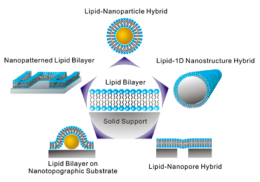脂質-ナノ構造体ハイブリッドおよびそのナノバイオテクノロジーへの応用
Lipid-nanostructure hybrids and their applications in nanobiotechnology
2013年5月17日 NPG Asia Materials 5, e5 (2013) doi:10.1038/am.2013.13
ナノバイオテクノロジー:脂質を用いたハイブリッド構造体

細胞膜は大部分が脂質とタンパク質から構成されており、これらの成分が頻繁に再構成を繰り返すことによって、さまざまな生物学的役割を担っている。こうした細胞膜に似た、脂質二重層をベースとした構造を作製し、細胞模倣材料や機能性材料(例えば薬物の封入・放出による薬物送達に利用可能な材料)として役立てることに大きな関心が寄せられているが、このような構造体は動的性質を持つため制御が難しい。しかし、この問題は固体(場合によっては多孔性)の支持体やカーボンナノチューブなどのナノ材料と組み合わせることによって避けることができ、さらには、脂質とナノ材料を組み合わせることによって多機能性も得られる。ソウル国立大学(韓国)のJwa-Min Namをはじめとする研究チームは今回、こうしたハイブリッドナノ構造体の作製や、制御可能なナノ構造体の組み立てに起因する特性、そしてそれらの生体分子や細胞、生体内作用に関する研究への応用について、最近の進展を概説している。ハイブリッド系は、生細胞との相互作用や細胞内事象を調べるための基盤技術として有望な材料である。
Nanobiotechnology: Hybrids with lipids
Cell membranes, which mostly consist of lipids and proteins, routinely rearrange to perform a variety of biological processes. There is much interest in fabricating lipid bilayer-based structures that resemble these membranes to serve as cell mimics or functional materials which, for example, have potential for use in drug delivery through the encapsulation and subsequent release of cargo. The dynamic nature of the structures, however, makes them difficult to control – an issue that can be circumvented by their assembly with other nanomaterials such as solid, and sometimes porous, supports or carbon nanotubes. Moreover, multifunctionality can also be obtained by combining lipids with nanomaterials. Jwa-Min Nam and co-workers from Seoul National University in Korea review recent advances in the synthesis of these hybrid nanostructures, the properties arising from their controllable assembly, and their application to the study of biological molecules, cells and processes. The hybrid systems show promise as a platform for interaction with live cells and the investigation of intercellular events.

